
* The Ilyushin-2 Shturmovik ground-attack aircraft was one of the most important Soviet combat aircraft of World War II. While Russian technology is not always highly regarded in the West, the Il-2 was well-designed and highly effective at its task, was produced in great quantity, and was one of the great combat aircraft of war. This document provides a history and description of the Il-2 and its improved derivative, the Il-10.
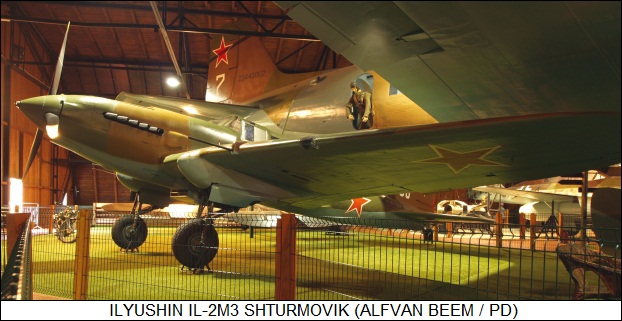
* The Soviet government was very interested in antitank aircraft during the 1930s, and inconclusive work was done on the concept through most of the decade. In late 1938, as war was becoming more likely, another design request for an antitank aircraft was issued, and a team under Sergei Vladimirovich Ilyushin at the Soviet Central Design Bureau came up with a new design, a two-seat aircraft designated the "TsKB-55", sometimes translated as "CKB-55". Two prototypes were ordered, the first of which first flew in October 1939. Another team under Pavel Sukhoi built a competing aircraft, the "Su-6" -- but the Sukhoi design was too late, and the Ilyushin aircraft won the contest.
Although initial evaluations had shown the TsKB-55 to be easy to fly, the tests also revealed some deficiencies. The initial prototype was modified within a few weeks to fix the problems and redesignated "TsKB-57". The revised first prototype was now a single-seater, and had a new engine since the original 1,030 kW (1,370 HP) Mikulin AM35 vee-12 engine had not been powerful enough. Part of the problem was that the AM35 had a two-speed supercharger, which wasn't needed for the low-level operations appropriate for a battlefield support aircraft; it actually robbed the engine of power, so it was replaced by a similar 1,260 kW (1,680 HP) AM38 with a single-speed supercharger. Flight trials with the new engine were performed in October 1940, and the aircraft proved much more satisfactory.
In the meantime, the second prototype, designated "TsKB-55P", had been completed, flying at the end of the December 1939. Since early evaluations of the first prototype had shown that the pilot had a poor forward view over the long inline vee engine, the TsKB-55P featured a lowered engine and a stepped-up cockpit, giving the aircraft a distinctive "humpbacked" look. The original design concept had been for the aircraft to be armed with four 7.62-millimeter ShKAS machine guns in the wings, but after some experiments the final fit was two 7.62-millimeter ShKAS machine guns and two 20-millimeter ShVAK cannon.
* The two prototypes demonstrated the usefulness of the Ilyushin concept, and Soviet factories began to set up for production in early 1941. The production aircraft was designated the "Il-2 Shturmovik" -- where "Shturmovik" meant "Storm Bird", a general term for a close-support aircraft.
The original Il-2 was a single-seater. The forward fuselage around the engine and cockpit was built with 700 kilograms (1,543 pounds) of steel ranging from 5 to 12 millimeters (a fifth to half inch) thick. The engine radiators were placed behind the engine in the armored body, while the air intakes were placed on top of the nose. K-4 armor glass was used in the cockpit, with thicknesses from 55 to 65 millimeters (2.2 to 2.6 inches).
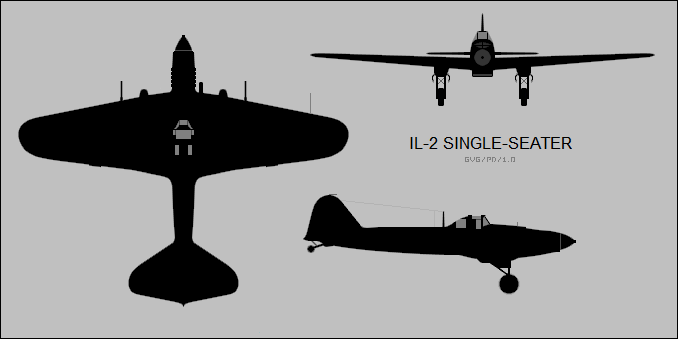
The aircraft featured tailwheel landing gear, with wide main undercarriage for rough field operations. The main wheels retracted into fairings on the wing, with the tires left exposed. This configuration was partly devised to reduce damage to the aircraft on a "wheels up" landing.
The Il-2 was armed, as mentioned, with two ShKAS 7.62-millimeter machine guns and two ShVAK 20-millimeter cannons; rails for eight 82-millimeter RS-82 rockets, making it one of the first attack aircraft to carry rockets; and light bombs. There were two small bomb bays in each wing inboard of the landing gear, and there were external racks under the wings as well. Total external warload was 400 kilograms (880 pounds). Level speed was 470 KPH (300 MPH), and operating altitude was 2,000 meters (6,600 feet).
249 Il-2s were built before the Germans invaded the USSR on 22 June 1941, inflicting a series of staggering military disasters on the Red Army. Only 18 Il-2s had been delivered to field units, pilots were not very familiar with the aircraft, and the Il-2 was not in a position to do the German invaders much damage for the time being.
Soviet resistance through the summer of 1941 was uncoordinated and outmatched by the enemy, though it presented enough difficulty to the invaders to slow their advance down. By that time, it was obvious that the aircraft factories around Moscow and other centers in western Russia were greatly at risk, and in a monumental undertaking they were relocated beyond the Urals under the most difficult conditions. Ilyushin and his engineers were busy during this time, rethinking their production techniques, and only two months after the relocation had begun, Il-2s were again coming off the production line. Production was slow to get started, but two plant managers, Shenkman and Tretiakov, were encouraged to do their utmost by a telegram:
BEGIN_QUOTE:
YOU HAVE LET DOWN OUR COUNTRY AND OUR RED ARMY. YOU HAVE NOT MANUFACTURED IL-2S UNTIL NOW. THE IL-2 AIRCRAFT ARE NECESSARY FOR OUR RED ARMY NOW, LIKE AIR, LIKE BREAD. SHENKMAN PRODUCES ONE IL-2 A DAY AND TRETIAKOV BUILDS ONE OR TWO MIG-3S DAILY. IT IS A MOCKERY OF OUR COUNTRY AND THE RED ARMY. I ASK YOU NOT TO TRY THE GOVERNMENT'S PATIENCE, AND DEMAND THAT YOU MANUFACTURE MORE ILS. I WARN YOU FOR THE LAST TIME. STALIN.
END_QUOTE
With such inspirational encouragement, production ramped up rapidly. The notion that the Shturmovik was "like bread" became part of the culture of the manufacturing plants. Il-2s became available in quantity, and Red pilots found them an effective weapon.
However, field experience demonstrated serious deficiencies in the aircraft. While the aircraft was easy to fly and had few vices, the 20-millimeter main cannon didn't have enough killing power, and the aircraft was very vulnerable to fighter attacks from above while engaged in low-altitude combat. The Ilyushin design team had a meeting with representative operational pilots in the spring of 1942, and decided on a number of improvements.
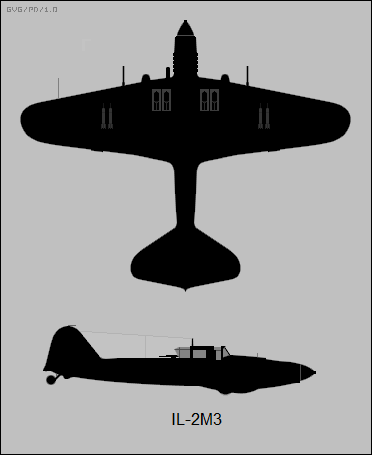
The improvements were implemented in two steps, the first being the "Il-2M", in which the two 20-millimeter ShVAK cannon were replaced with twin high-velocity 23-millimeter VYa cannon, and which incorporated an upgraded AM38F engine rated at 1,310 kW (1,750 HP). This variant was quickly followed by the two-seat "Il-2M3", in which the cockpit was lengthened to accommodate a gunner, who manually handled a single 12.7-millimeter UBT machine gun, on a flexible mount at the back of the cockpit and directed upward and backward. Armor was increased from 700 kilograms to 950 kilograms (2,100 pounds), partly to protect the back-seater.
___________________________________________________________________
ILYUSHIN IL-2M3 SHTURMOVIK:
___________________________________________________________________
wingspan:
14.6 meters (47 feet 11 inches)
wing area:
38.5 sq_meters (414.4 sq_feet)
length:
11.65 meters (38 feet 2 inches)
height:
4.17 meters (13 feet 8 inches)
empty weight:
3,400 kilograms (7,500 pounds)
MTO weight:
5,870 kilograms (12,950 pounds)
take-off run:
400 meters (1,310 feet)
maximum speed:
425 KPH (264 MPH / 230 KT)
ceiling:
4,525 meters (14,485 feet)
range:
600 kilometers (405 MI / 350 NMI)
___________________________________________________________________
Despite the heavier armor, performance hardly suffered. The longer cockpit improved the machine's aerodynamics, a slightly improved AM38F engine provided incremental horsepower, and structural changes trimmed the weight of other parts of the aircraft, resulting in a net gain of only 100 kilograms (220 pounds). With the aircraft's major defects now corrected, the Shturmovik came into its own.
BACK_TO_TOP* When the Germans began their drive on Stalingrad on 23 August 1942, Red resistance in the air was almost negligible, and the Luftwaffe pounded the city in major raids with effective impunity. As their ground offensive bogged down into savage house-to-house fighting in the city, however, the Soviets were building up their forces for a counterstroke. On 19 November 1942, the Red Army counterattacked in a successful drive to encircle the German 6th Army, supported heavily by artillery, tanks, and over 1,400 aircraft.
White-painted Shturmoviks were the most prominent participant in the battle in the air, performing roughly a thousand sorties over the next four days, skimming in at altitudes of 20 meters (64 feet) or less to smash German armor, artillery, and infantry. Weather was so bad during the initial days of the counterattack that the Luftwaffe was unable to respond to the Soviet air onslaught. When the weather cleared on 24 November, German fighters began to respond more effectively, but the Red air fleets kept up the pressure, flying 6,000 sorties over the next week.
Through December into January 1943, the hammering continued. The Luftwaffe attempted to resupply their encircled troops from the air, but even if there had been no air opposition, there wasn't the airlift capability to do the job, and for the first time in the war the Red Air Force was effectively challenging German air superiority. On 2 February 1943, what remained of the encircled German 6th Army surrendered.
* The Shturmovik had been an important element in the victory, and as fighting continued into the spring of 1943, so did improvements to this vital Soviet weapon. Most significantly, in some production the two 23 millimeter VJa cannon were replaced by a pair of long-barreled 37-millimeter NS-37 cannon, with this variant known as the "Il-2-37". Each gun had 50 rounds of ammunition. This variant saw service, but it did not prove highly successful -- the big guns had a hefty recoil and badly affected the aircraft's handling.
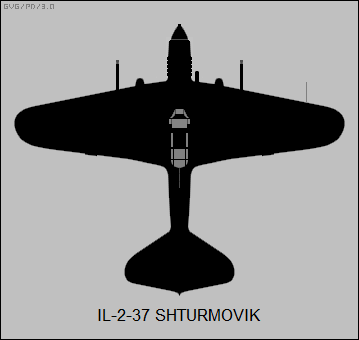
The Il-2M3 also carried other ordnance. One was the PTAB anti-tank bomblet, which was a 2.5-kilogram (5.5-pound) hollow-charge munition. Up to a total 192 PTAB bomblets could be loaded into the Shturmovik's four little bomb bays, and could be scattered over enemy armored columns as a "steel rain" with considerable destructive effect. Another weapon was the DAG-10 grenade launcher, an odd "aerial-mine" device that would eject grenades on little parachutes in the path of a pursuer and which, surprisingly, Soviet sources say was very effective.
Many Il-2s also began to incorporate all-metal wings and tail surfaces. These improvements were just in time. During that spring, Hitler had planned an offensive to cut off a huge Soviet salient in German lines, centered around the small city of Kursk. However, the operation, codenamed CITADEL, was postponed until that summer so that the new heavily-armored Panther and Tiger tanks could participate, The Soviets, assisted by a spy codenamed "Lucy" whose network provided detailed intelligence on German intentions, were kept perfectly informed of enemy intentions, building their forces in and behind the Kursk salient to high levels. When the Germans attacked on 5 July 1943, the Red Army was ready for them.
Or at least, thought they were. The Soviets attempted to launch a preemptive air strike early that morning, but the Germans quickly sensed the move and sent up their own fighters, destroying 70 Red aircraft at little loss to themselves. German Army ground units made progress in their attack on the Soviet flanks. Within a day, however, the Soviets rallied, and on 7 July 1943 they responded with overwhelming attacks that smashed German panzer divisions. The Shturmoviks were in their element and delivered hammer blows to enemy tanks.
By this time, Shturmovik pilots had refined their tactics. Flying in attack groups of 8 to 12, in open country they would attack "soft" targets such as infantry or trucks by simply skimming in at 5 to 10 meters (16 to 32 feet) altitude. Against stationary "hard" targets such as bunkers they would use near-vertical dive-bombing attacks. Against armor moving in a column, they would proceed straight down the column or weave over it in a shallow S-curve, dropping their PTAB antitank bombs from an altitude of 100 to 150 meters (320 to 480 feet).
Against armor in offensive formation, however, they preferred the "Circle of Death" attack, in which a Shturmovik group would flank around the enemy and then peel off successively, each Il-2 making a shallow diving attack, then pulling up and around for another pass. The beauty of the Circle of Death was that it kept the enemy under continuous fire for as long as the aircraft had fuel and ammunition. One Shturmovik pilot, Senior Lieutenant Alexander Yefimov, wrote: "We usually tried to attack from the rear, where the armor was thinner and where the most vulnerable components of the vehicles were located: the engines and the gas tanks." He proudly added that "the effect was staggering as Hitler's celebrated Tigers burned under the strikes." Il-2M3s armed with 37-millimeter guns were able to destroy Panthers and Tigers with their guns alone, blasting into their thinner top armor.
The Shturmovik's armor made it generally invulnerable to anything less than 20-millimeter fire. Even that had to be accurate and precise to do the aircraft damage, and an Il-2 moving fast and jinking wildly at low altitude was very hard to hit. Despite their survivability, Shturmovik losses were high, for they fought in the teeth of the worst combat with no place to hide. Soviet factories continued to churn out the simple, reliable aircraft, and those that fell were quickly replaced with new aircraft with weaknesses eliminated. Red pilots refined their tactics and training to help reduce the losses.
The Kursk salient became a storm of combat, but on 13 July Hitler, confronted with the Anglo-American invasion of Sicily, called off CITADEL. The Battle of Kursk was a significant Soviet victory, and would soon lead to pressing back the Germans all along the Eastern Front. The Shturmovik had made a major contribution to the success of Red arms. Il-2s destroyed 70 tanks of the 9th Panzer Division in a mere 20 minutes, inflicted losses of 2,000 men and 270 tanks in two hours of attack on the 3rd Panzer Division, and effectively destroyed the 17th Panzer Division in four hours of strikes, smashing 240 vehicles out of their total of almost 300.
* At the end of 1943, most of the USSR was back in Soviet hands. Only Belorussia remained under German occupation. To dislodge them, Stalin and his generals planned a massive offensive under the code name BAGRATION, after a Czarist general of the Napoleonic wars. BAGRATION jumped off on 22 June 1944, the third anniversary of the German invasion. More than 6,000 planes participated, with a third of them Shturmoviks. Yefimov wrote: "With precise, low-altitude strikes, they completely destroyed the fascists' concrete emplacements, smoked them out of their concrete pillboxes and, with cannon, rocket and machine-gun fire, destroyed Hitler's soldiers."
By this time, the Shturmovik's arsenal had been upgraded still further, with the 132-millimeter RS-132 rocket providing greater hitting power than the older RS-82 weapon. The new rockets carried either a hollow-charge warhead for attacking armor, or a high-explosive warhead for strikes on buildings and fortifications.
By 4 July 1944, the operation was over except for the mopping up. German Army Group Center had suffered 300,000 casualties and had been effectively destroyed. The Germans had been driven out of the USSR, and now the Soviet war machine was ready to drive into Eastern Europe in pursuit. Once again, the Il-2 had been a critical weapon in the victory. To Shturmovik pilots, the aircraft was simply the feminine "Ilyusha". To the soldiers on the ground it was the "Hunchback", or the "Flying Tank", or, the greatest of compliments, the "Flying Infantryman". The enemy, it is said, called it "Schwarz Todt", the Black Death. That nickname may have just been an invention of Soviet propaganda -- but the Germans certainly had reason to fear and dread the Il-2.
BACK_TO_TOP* In 1943, Ilyushin and his engineers had considered what they could do to improve on the Il-2 by essentially redesigning it from scratch. The result was the "Il-10", which looked very much like a cleaned-up Il-2, but was of all-metal construction, gave the rear gunner a powered turret with a single 20-millimeter gun instead of the flexible 12.7-millimeter gun, and had such aerodynamic features as main wheels that rotated 90 degrees to fit inside the wheel fairings.
___________________________________________________________________
ILYUSHIN IL-10 SHTURMOVIK:
___________________________________________________________________
wingspan:
13.4 meters (44 feet)
wing area:
30.0 sq_meters (322.9 sq_feet)
length:
11.06 meters (36 feet 4 inches)
height:
4.17 meters (13 feet 8 inches)
empty weight:
4,680 kilograms (10,317 pounds)
MTO weight:
6,535 kilograms (14,407 pounds)
take-off run:
400 meters (1,560 feet)
maximum speed:
530 KPH (330 MPH / 285 KT)
ceiling:
7,250 meters (23,785 feet)
range:
800 kilometers (500 MI / 430 NMI)
___________________________________________________________________
There were only two bomb bays instead of four. Postwar production would also have four 23-millimeter cannon, instead of two 7.62-millimeter machine guns and two 23-millimeter cannon. Il-10s began reaching combat units in October 1944, joining the tens of thousands of Il-2s already in service, in preparation for the last drive on Hitler's Reich.
After the fall of Warsaw on 17 January 1945, the final push on Germany began on 16 April 1945, as the Red Army crossed the Oder and Neisse rivers, the last major geographic obstacles in front of Berlin. In the northern sector of the battle zone, where the seacoast terrain was littered with swamps, armor and artillery were useless, and the Shturmovik was the only means of tactical support.
An Il-2 pilot wrote: "The vectoring stations [ground forward air controllers] provided us with precise coordinates of where the strikes should be delivered. At other times, our missions were provided after we were already airborne and, 5-10 minutes later fire rained down on the enemy, destroying his men and equipment." Eventually, "things reached a point where, after expending all our ammunition -- bombs, shells, rockets, and machine-gun belts -- we continued to fly over the battlefield at low altitudes, sowing panic and fear." The Red Army pressed into Berlin in bitter house-to-house fighting. On 30 April, Adolf Hitler committed suicide, and on 1 May the Germans surrendered.
* With the defeat of Germany, the era of the Shturmovik was over. The Il-10 would be later used in the Korean War, but by that time it would be more of a flying coffin than a flying tank, and its usage would fade away in the early 1950s.
During the Great Patriotic War against the Germans, the Shturmovik operated in a number of unusual roles besides close-support aircraft, such as reconnaissance, smoke laying, and even some transport work. Sometimes transport work was an improvised matter: Shturmovik pilots were reported to have rescued colleagues whose aircraft had gone down by lashing them to the landing gear and making the trip home with their gear down.
The Shturmovik may have been the only Soviet aircraft to operate in joint combat with American aircraft. On 8 May 1945, four American Lockheed P-38 Lightnings joined two squadrons of Il-2M3s over Austria in an attack on a German road column.
The Soviet Navy flew many Il-2s, using them to perform "mast-top bombing", which was the same as the American "skip bombing" technique, coming in at low level and skipping a delayed-action bomb off the waves into the side of a ship. The Navy also flew a land-based torpedo bomber variant under the designation "Il-2T".
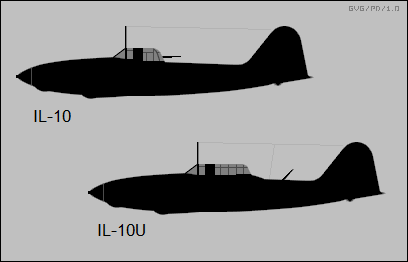
There were a number of other minor variants of the Shturmovik. The "Il-2KR" was intended as a battlefield spotting and reconnaissance aircraft, and had a more powerful radio and a camera. There was a dual-control conversion trainer, the "Il-2U". Sergei Ilyushin also designed a scaled-up version of the Il-2 designated the "Il-8"; it was much like the Il-10, but about a meter (3 feet 3 inches) longer. Flight tests showed that it didn't provide sufficient advantage to dislocate production, and so the Il-8 was abandoned.
Another interesting dead-end variant was the "Il-2I" armored fighter. This variant returned to the single-seat format, with the bomb bays and the two 7.62-millimeter machine guns removed, leaving the two 23-millimeter guns for air combat. External bomb racks were retained. Trials demonstrated that the idea wasn't as useful in practice as it sounded on paper, and the armored fighter was abandoned as well.
* Many Shturmovik pilots performed heroic deeds in their fight for the Motherland, and several were awarded decorations as Heroes of the Soviet Union. One pilot named Briuhanov flew 140 combat missions, credited with destroying 40 tanks, 3 self-propelled guns, a train, 152 other ground vehicles, 20 mortar emplacements, and 34 antiaircraft positions. He was killed in the last month of the war in Europe.
While the Soviets had all-female aircraft regiments, there were no such formations of Shturmoviks. However, women did fly the Il-2 in combat. The most famous of them was Senior Lieutenant Anna Yegorova, who flew 260 missions and was decorated three times, the last posthumously, for she was shot down and presumed dead. In fact, though she was severely mistreated by her German captors, she did in fact survive to be liberated. Pictures show her to be striking and photogenic. Besides being a good fighter, she was likely a useful instrument for the energetic Red propaganda machine.
* Total production of the Shturmovik was over 36,000 Il-2s of all makes and some 6,000 Il-10s, a total of over 42,000, making it one of the most heavily produced aircraft in history. Its preeminence in its role is indicated by the fact that the term "Shturmovik", or "Storm Bird", is a general Soviet designation for an attack aircraft, but came to be uniquely descriptive of the Il-2.
There are a number of Il-2s and Il-10s on static display in museums and the like, but there were no flying examples left -- until 2011, when a Russian restoration crew managed to bring a derelict up to pristine flight status. The restoration was for an American warbird collector. Lacking Klimov engines, the machine was fitted with an Allison V-1710 water-cooled vee-12 engine.
BACK_TO_TOP* American World War I fighter ace Eddie Rickenbacker was shown a demonstration of the Shturmovik during a visit to the USSR, leaving him extremely impressed. He reported it the best attack aircraft in existence, that the USA had never built anything like it, and that such a machine should be part of every army.
I cannot recollect that I had ever had any awareness of the Il-2 until a few years ago. For some reason, I never had much interest in WWII Soviet aircraft when I was a boy, probably because they seemed crude.
In one sense, the Shturmovik was elegant, superbly designed in a direct and efficient fashion for its task, but for that same reason it was crude, in the same sense that a sledgehammer is crude. It had no adornments and was dedicated to its function without regard for aesthetics. This, to a more-or-less grown-up engineer, gives the aircraft its interest. While dogfighters are the glory boys of combat aviation, purpose-built mudfighters like the Il-2, A-1 Skyraider, or the A-10 Warthog are no-BS weapons and look the part.
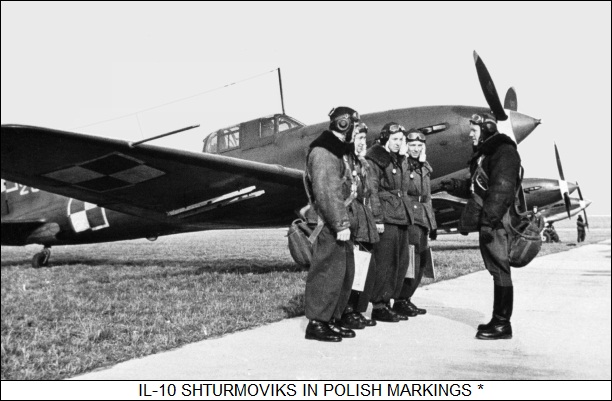
* Sources for this document include:
The mix of sources for this document make for lively reading. I do have the suspicion, however, that much of the anecdotes about the Il-2's feats are parrotings of old Soviet propaganda. Such is history: the fuzzy lens through which we view the past.
* Revision history:
v1.0 / 04 sep 96 v1.1 / 01 feb 00 / Minor additions. v1.2.0 / 01 dec 02 / Review & polish. v1.2.1 / 01 dec 04 / Review & polish. v1.2.2 / 01 dec 06 / Review & polish. v1.2.3 / 01 nov 08 / Review & polish. v1.2.4 / 01 oct 10 / Review & polish. v1.2.5 / 01 oct 12 / Review & polish. v1.2.6 / 01 sep 14 / Review & polish. v1.2.7 / 01 aug 16 / Review & polish. v1.2.8 / 01 jul 18 / Review & polish. v1.2.9 / 01 may 20 / Review & polish. v1.3.0 / 01 mar 22 / Review & polish. v1.3.1 / 01 feb 24 / Review & polish. (+)BACK_TO_TOP
